<Back to Index>
- Warsaw Area Leader of the Schutzstaffel Oberführer Ferdinand von Sammern - Frankenegg, 1897
- Warsaw Area Leader of the Schutzstaffel Gruppenführer Jürgen Stroop, 1895
- Commander of the Warsaw Security Police Standartenführer Ludwig Hermann Karl Hahn, 1908
- Officer of the Schutzstaffel Erich Steidtmann, 1914
- Officer of the Schutzstaffel Franz Bürkl, 1911
PAGE SPONSOR
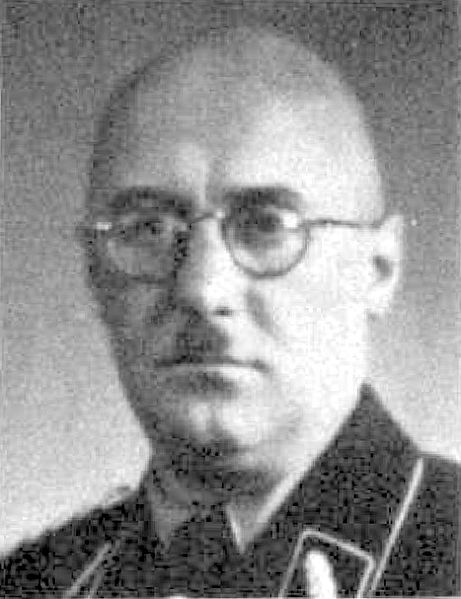
Ferdinand von Sammern - Frankenegg (17 March 1897 - 20 September 1944) was an Austrian SS functionary (Brigadeführer) during the Nazi era. He was born in Grieskirchen. Von Sammern - Frankenegg served in World War I as a member of the Kaiserschützen, then of the K.u.k. Feldjäger and then after Austria - Hungary had formally surrendered, in the German Freikorps Oberland and the Steirischer Heimatschutz. Ferdinand von Sammern - Frankenegg earned his PhD in legal studies at the University of Innsbruck in 1922. He had been a member of the dueling fraternity Universitätssängerschaft Skalden zu Innsbruck. Von Sammern - Frankenegg worked as a lawyer in Peuerbach.
He served as SS and Police Leader of the Warsaw area in German occupied Poland from 1941 until 1943 during World War II.
Sammern - Frankenegg was in charge of the Großaktion Warschau, the single most deadly operation against the Jews in the course of the Holocaust in occupied Poland, which entailed sending between 254,000 and 265,000 men, women and children aboard overcrowded Holocaust trains to the extermination camp in Treblinka. The "liquidation" of the Warsaw Ghetto between 23 July and 21 September 1942 was disguised as a "resettlement action" in order to trick the victims into cooperating. It was a major part of the murderous campaign codenamed Operation Reinhard in the Final Solution. Von Sammern - Frankenegg remained in Warsaw until his first offensive operation in the suppression of the Warsaw Ghetto Uprising on 19 April 1943, which was unsuccessful.
After the failed offensive, von Sammern - Frankenegg was replaced by Jürgen Stroop, and court martialed by SS leader Heinrich Himmler on 24 April 1943 for his alleged ineptitude; which, for the SS, meant only one thing: guilty of "defending Jews". He was subsequently transferred to Serbia where in September 1944 he was killed in a Yugoslav partisan ambush near the town of Klašnić.
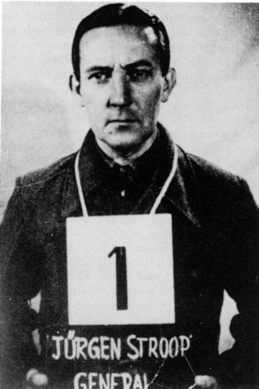
Jürgen Stroop, (born Josef Stroop, September 26, 1895, Detmold, Germany - March 6, 1952, Warsaw, Poland), was a high ranking Nazi Party and SS official during World War II. He was best known for his role in liquidating the Warsaw Ghetto and for his book length account of the operation: a document originally titled The Warsaw Ghetto Is No More. Following Germany's defeat, Stroop was sentenced to death for war crimes by a U.S. military tribunal during the Dachau Trials in 1947. He was later extradited to Poland where he was also tried and convicted of crimes against humanity. He was hanged by Polish authorities in 1952.
Jürgen Stroop was born in Detmold, in the Principality of Lippe, German Empire, the son of a police officer. In conversation with Kazimierz Moczarski, Stroop recalled that his mother was far more devoutly Roman Catholic than his father. Both, however, were enthusiastic monarchists. The elder Stroop often expressed hope that his son would also loyally serve Leopold IV, Prince of Lippe.
After receiving an elementary education, he became an apprentice with the land register in Detmold, where he worked until the outbreak of World War I. He joined the Imperial German Army in 1914 as a volunteer, served in several infantry regiments at the Western Front. Stroop was awarded the Iron Cross 2nd Class and was wounded in action. Stroop subsequently served on the Eastern Front and in Romania. At the end of the war, he held the rank of a vice - Feldwebel (Sergeant). After the Armistice, Stroop returned to work at the land register, while remaining active in a veterans' organization.
During the 1920s, Stroop embraced Germanic neo - paganism under the influence of General and Mathilde Ludendorff. He later recalled,
"We found the Ludendorffs' views extremely attractive, especially hers. She was the one who revealed the truth about the Catholic Church in Germany and returned us to the true Germanic gods. By recalling the pure, pre - Germanic ways, she pointed out the rottenness of the Judeo - Christian ethic and showed how the organized Church had been strangling the Reich for twelve hundred years. If she hadn't been a woman, we would have made the Frau Doktor an honorary member of our veterans' associations. It was thanks to what I was lucky enough to learn from her books that I was able to rid myself of religious prejudice and mark Gottgläubig in the column concerning belief."
Stroop joined the NSDAP and SS in 1932. In 1933, he was appointed leader of the state auxiliary police. One year later, he was promoted from the rank of SS-Oberscharführer to the rank of SS-Hauptsturmführer. Subsequently he worked for the SS administration in Münster and Hamburg. In the autumn of 1938, he was promoted again, this time to the rank of SS-Standartenführer (colonel) and served in the Sudetenland. After the invasion of Poland, he served as commander of the SS-section in Gnesen (Gniezno). During the occupation of Poland, Stroop was transferred to Poznan as head of Selbstschutz, the notorious "self - defense" formation of the local ethnic Germans.
In May 1941, Stroop changed his name from Josef to Jürgen for ideological reasons and in honor of his deceased son. From 7 July to 15 September 1941, Stroop served in combat on the eastern front with the infantry regiment of the 3rd SS Division Totenkopf. He was awarded a Clasp to the Iron Cross 2nd Class and an Infantry Assault Badge in Bronze. On 16 September 1942, he was promoted to SS-Brigadeführer and assigned as an Inspector of the SiPo and SD of the Higher SS and Police Leader for Russia South. In this position Stroop worked to help secure a key logistical route for German forces on the Eastern Front. Beginning in October 1942, Stroop commanded an SS garrison at Kherson, before becoming the SS and Police Leader (SSPF) for Lemberg (Lviv) in February 1943.
Stroop's most historically prominent role was the suppression of the Warsaw Ghetto Uprising, an action which cost the lives of over 50,000 people. He was sent to Warsaw on 17 April 1943 by Heinrich Himmler, as a replacement for SS-Oberführer Ferdinand von Sammern - Frankenegg, who was relieved of duty. Stroop took over from Sammern - Frankenegg following the latter's failure to suppress the uprising at the onset:
I had two battalions of Waffen-SS, one hundred army men, units of Order Police, and seventy - five to a hundred Security Police people. The Security Police had been active in the Warsaw ghetto for some time, and during this program it was their function to accompany SS units in groups of six or eight, as guides and experts in ghetto matters.
Stroop had recently been involved in operations against Soviet partisans in Ukraine and was familiar with the latest German counter insurgency tactics. He ordered the entire ghetto to be systematically burned down and blown up building by building, and all of Warsaw's Jews to be killed or deported to extermination camps. After the uprising was suppressed, he prepared a detailed record of the operation, a 75-page report, bound in black leather and including copies of all communiqués sent to SS Police Leader East Friedrich - Wilhelm Kruger and photographs. Originally titled "The Jewish Quarter of Warsaw is no more!", it is commonly referred to as "The Stroop Report" and would later be used as evidence at the Nuremberg Trials. Stroop then formally assumed the position of SS and Police Leader of Warsaw. Kruger presented an Iron Cross 1st Class to him on 18 June 1943 for the Warsaw Ghetto "action" at a gala reception in Warsaw’s Lazienki Park.
Stroop was subsequently named the Higher SS and Police Leader (HSSPF) in Greece on 8 September 1943. The local civilian administration found his methods and behavior unacceptable and withdrew cooperation, forbidding the local Order Police from having anything to do with him, which made his position untenable. Consequently, he was removed and on 9 November was appointed Commander of SS-Oberabschnitt Rhein - Westmark (an SS administrative district named for the Rhine and Gau Westmark) in Wiesbaden, serving there until the close of the war.
In early May 1945, Stroop was captured by American forces in the town of Rottau in Bavaria. Wearing the uniform of an infantry officer, he bore false discharge papers made out to a Wehrmacht Captain of Reserve Josef Straub. He kept to this story for nearly two months, before admitting to being Jürgen Stroop on 2 July.
He was then put on trial by the U.S. Military Tribunal at Dachau (Dachau Trials) for the summary executions of Allied airmen (Fliegermorde), shot down over Germany in his field of command. On 21 March 1947, he was sentenced to death by the tribunal. However, that sentence was not carried out; instead, he was extradited for trial in the People's Republic of Poland.
While awaiting trial in Warsaw's Mokotów Prison, Stroop was placed in the same cell with Kazimierz Moczarski, a former member of Poland's anti - Nazi Armia Krajowa. Following the creation of Poland's communist government by local comsyp stooges, Moczarski had been jailed by the Ministry of Public Security, spending four years on death row.
In conversation with Moczarski, Stroop opened up in detail about his life. He also gleefully recalled his involvement in the destruction of Warsaw's Great Synagogue:
"What a wonderful sight! I called out, Heil Hitler! and pressed the button. A terrific explosion brought flames right up to the clouds. The colors were unbelievable. An unforgettable allegory of the triumph over Jewry."
Stroop also informed Moczarski of what he considered the real reasons for the Third Reich's collapse. He said, "We lost the war for one reason only! The plotting of internationalist factions. The Communists, Socialists, Jews, Reactionaries, Anglo - Saxons, Freemasons and Catholic elements tore our nation apart. What's more, the Reich could never have been defeated without the help of traitors like Canaris, Goerdeler, Stauffenberg, Thalmann, Schumacher, Niemöller, Kluge, Paulus, Pieck, and scum like that Norwegian Willy Brandt. History proves that we were too liberal, Herr Moczarski. We should have muzzled those scoundrels more tightly."
On November 11, 1949, Stroop and Moczarski were separated by prison authorities. Knowing that they would never meet again, Stroop reminded Moczarski that it was Poland's independence day and the thirty - first anniversary of the German Empire's defeat in World War I. Before their final parting, the two former enemies shook hands.
On 23 July 1951, after a trial lasting three days, a Polish court sentenced Stroop and Franz Konrad to death by hanging. Stroop was hanged on 6 March 1952, outside the Mokotow prison in Warsaw.
After his release in 1956, Moczarski wrote a book about his time with Stroop, titled Rozmowy z katem (Conversations with an Executioner). Portions of the book appeared in newspapers and magazines in parts while Moczarski was still alive. The entire manuscript was not published in its complete form until after Moczarski's death, posthumously published in 1977. Another edition was released in 1981. Conversations with an Executioner has since been translated into several languages.
- "How could they consider harming their Fuehrer? Adolf Hitler was placed on earth by a higher power, perhaps Wotan himself, to fulfill a sacred mission. The July conspiracy was an example of the moral decay that proved to be our undoing. It would have been impossible to defeat Germany without German participation, Herr Moczarski. If it hadn't been for negligence disguised as tolerance, we could have held off the whole world. Instead, we allowed degenerate forces to pollute our healthy masses. A few weaklings poisoned by enemy agents and infected with subversive ideologies were all it took to undermine us. The minute we suffered military defeats, the cancerous elements in our society swung into action, organizing Mafias and creating 'patriotic discussion groups.' In the end, they destroyed our nation."
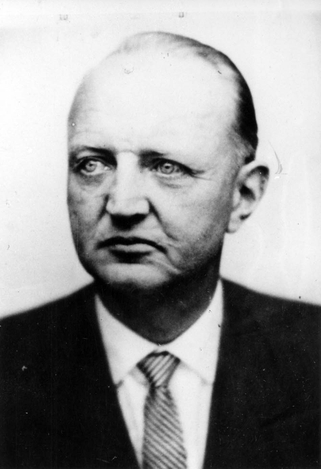
Ludwig Hermann Karl Hahn (23 January 1908 - 10 November 1986) was a German SS-Standartenführer, Nazi official and convicted war criminal. He held numerous positions with the German police and security services over the course of his career with the Schutzstaffel (SS).
As a senior officer of the Sicherheitspolizei (Security Police) and Sicherheitsdienst (Security Service) in occupied Poland, Hahn was directly involved in the destruction and liquidation
of the Warsaw Ghetto (1942) and the brutal suppression of both the
Warsaw Ghetto Uprising (1943) and the Warsaw Uprising (1944).
The son of a prosperous farmer of the same name, Hahn was born on January 23, 1908, in the rural town of Eitzen, Uelzen district, Province of Hanover in what was then the German Empire. Hahn attended Volksschule as a youth and was then enrolled at the Lüneburg Realgymnasium, graduating in 1927.
Hahn went on to study financial law at the University of Göttingen
where he became a member of the National Socialist German Students'
League. In February 1930 he joined both the Nazi Party (NSDAP Nr. 194
463) and the Sturmabteilung (SA), where he would rise to the rank of Scharführer (corporal). After successfully defending his dissertation before the Faculty of Law at the University of Jena, Hahn obtained his doctorate of jurisprudence (Dr. jur.) in July 1932. He joined the Schutzstaffel
(SS) in April 1933 (SS Nr. 65 823) and was assigned to the 17th
SS-Standarte (regiment) in Lüneburg and later transferred to the 26th SS-Standarte in Hamburg.
After attending the Nazi Party's State School for Leadership and Politics, Hahn joined the Sicherheitsdienst (SD) in May 1934 and was attached to the SS Regional Headquarters in Weimar as a member of the Stabswache. Hahn qualified as a lawyer after completing his legal clerkship in April 1935 and became a member of the National Socialist Association of Legal Professionals (NS-Rechtswahrerbund). That same year he married Charlotte Steinhoff, sister of the Luftwaffe fighter pilot Johannes Steinhoff, who later served as a senior General with the postwar West German Air Force and was also Chairman of the NATO Military Committee from 1971 to 1974. The couple would have four children.
Hahn began his career with the Nazi security services in June 1935 when he was employed as a consultant (Referent) by the SD-Hauptamt in Berlin. The following year he served as Deputy Director of the Gestapo bureau in Hanover, before returning to Berlin in November 1936 to work as a legal counselor (Regierungsassessor) at Gestapo Headquarters. Hahn underwent military training with the Wehrmacht in Frankfurt an der Oder and was subsequently reassigned to Weimar as Director of the city's Gestapo branch (Kriminalrat) and Deputy Chief of the Security Police (Stellvertreter Polizeiprasident). He would hold both positions from April 1937 to August 1939.
Hahn was promoted to the rank of SS-Sturmbannführer (major)
in September, 1938. During the build-up to World War II he was
transferred to Vienna, Austria in preparation for the looming invasion of Poland. He was assigned to Einsatzgruppe I under the command of Brigadeführer Bruno Streckenbach, and was given command of the sub-unit of Einsatzkommando 1/I.
During the invasion of Poland in September 1939, Hahn and his unit were
attached to the German 14th Army in the territories of Silesia and Malopolska.
Hahn and his Einsatzkommando took part in the arrests and executions carried out as part of Intelligenzaktion, the Nazi extermination campaign targeting the Polish intelligentsia. Between September and November 1939 Hahn and Einsatzgruppe I were involved in the mass killing of Polish public officials, activists, intellectuals and army officers in the cities of Katowice, Sanok and Podlesie. They also played a leading role in the expulsion of the Jewish population from the town of Dynow and managed their subsequent deportation into Soviet occupied eastern Poland.
Beginning in January 1940 Hahn took over as Commander of the Sicherheitspolizei (SiPo) and Sicherheitsdienst (SD) in the occupied city of Kraków. Here he would oversee Sonderaktion Krakau, an SS operation which involved the deportation of hundreds of professors and other academics from Jagiellonian University to various concentration camps in Germany. He also served as chief of the "Police Emergency Court" (Standgericht) at Montelupich Prison. In this capacity Hahn was instrumental in the implementation of the German AB-Aktion in Poland.
In August 1940 Hahn was transferred to Bratislava, Slovakia where had been appointed Special Representative (Sonderbeauftragter) of the Reichsführer-SS. In this position Hahn served as SS leader Heinrich Himmler's personal emissary to the Nazi allied government of the Slovak Republic under Jozef Tiso. From April to June 1941 Hahn was stationed in Athens, Greece where he commanded Einsatzgruppe Griechenland during the Balkan Campaign. Following the German victory in the offensive, he was promoted to the rank of SS-Obersturmbannführer (lieutenant colonel) and returned to his diplomatic post in Slovakia.
In August 1941, Hahn returned to Poland and was appointed Commander of the SiPo and SD for the city of Warsaw. During his tenure Hahn was directly involved in the implementation of the Holocaust in Poland. While serving under SS and Police Leader Ferdinand von Sammern - Frankenegg in the summer of 1942, Hahn collaborated with Brigadeführer Odilo Globocnik and other personnel associated with Operation Reinhard to carry out the destruction and liquidation of the Warsaw Ghetto. Nearly 265,000 Jews perished in the operation, either in mass shootings conducted by the SS or after being deported to the extermination camp at Treblinka.
As a deputy officer to SS and Police Leader Jürgen Stroop, Hahn also had a leading role in the bloody suppression of the Warsaw Ghetto Uprising in April and May 1943. The brutal pacification of the ghetto by the SS resulted in the deaths of 13,000 Jews either killed in the fighting or executed. Hahn later orchestrated the deportation of another 56,000 Jews from Warsaw to Treblinka in the aftermath of the rebellion. In April 1944, Hahn was promoted to the rank of SS-Standartenführer (colonel) and received the further title of Oberst der Polizei.
During the August - October 1944 Warsaw Uprising by the Polish Home Army Hahn fought with the Waffen-SS,
leading a battalion
of 700 men in the southern districts of the city and later in the
downtown area. He also personally commanded the defense of Warsaw’s
heavily fortified government district. Following the capitulation of the
uprising, Hahn, acting on instructions from Himmler, ordered the
mass-killing of Polish civilians
in retaliation for the rebellion. Between August and September of 1944
an estimated 5 to 10 thousand men women and children were shot by the
Gestapo, mainly in the ruins of the former General Inspectorate of the
Armed Forces. Hahn was awarded the Iron Cross, 1st Class for his service
in the Uprising.
In November 1944, Hahn departed Warsaw and returned to Germany. He was stationed in the town of Cochem and was appointed commander of Einsatzgruppe L which was attached to the German Sixth Panzer Army during the Battle of the Bulge. After the failure of the Ardennes offensive, Hahn was transferred to Army Group Vistula on the Eastern Front to serve as a delegate for the SiPo and SD on the general staff of SS-Obergruppenführer Carl Oberg during the Vistula - Oder offensive. In February 1945, he was reassigned to Dresden, where he briefly served as Stabsführer (chief of staff) to SS-Gruppenführer Ludolf von Alvensleben, the Higher SS and Police Leader for the Elbe.
Hahn was next appointed Commander of the SiPo and SD
for the city of Wiesbaden in March, 1945. However, he was quickly
displaced from this position after the city fell to the Allies and
instead took over as Commander of the SiPo and SD for Gau Westphalia-North. Hahn was also charged with overseeing the security detail for Gauleiter Alfred Meyer. During the final weeks of the war Hahn and his staff fled to Hessisch - Oldendorf
to escape the Allied advance. He was taken prisoner by the British Army
on April 12, 1945 but successfully escaped from custody shortly
afterward.
Hahn remained in Germany after 1945 and went into hiding in Bad Eilsen in the British occupation zone, working for several years as a laborer and farmhand. He later moved to Wuppertal where he worked as a salesman with the textile company of Scharpenack & Teschenmacher. He resumed using his real name in 1949. At a denazification hearing in 1950, Hahn's wife Charlotte falsely claimed to British authorities that her husband had been taken prisoner by the Russians and deported, prompting the British Army to end its war crimes investigation of him.
Afterward, Hahn would go on to pursue a successful postwar career as an insurance broker in West Germany.
In 1951 his father - in - law arranged for him to take a position as Deputy
Director for Organizational Matters with the Hanover branch of Karlsruher Lebensversicherung A.G.
He rose to the office of branch manager in 1955. Hahn and his family
relocated to Hamburg in 1958 where he had been hired as head of the life
insurance division of Hans Rudolf Schmidt & Co. GmbH. The family settled in a comfortable home in the suburb of Bonningstedt.
Hahn's identity was uncovered by journalists in 1960. Following an inquiry by the Central Office of the State Justice Administrations for the Investigation of National Socialist Crimes, Hahn was arrested by the West German federal police for his suspected involvement in the destruction of the Warsaw Ghetto. He was held by West German investigators for a year, however no charges were brought and he was released in 1961. Following his release Hahn took a position with the Hamburg branch of Investors Overseas Service. He retired in 1967.
He was again arrested by West German police in 1965 and again in 1966 but was only briefly held each time and never charged with any crime. It was not until May 1972 that Hahn was successfully charged with war crimes by the Higher Regional Court of Hamburg. The now 65 year old Hahn was found guilty in connection with wartime atrocities committed at the Pawiak prison in Warsaw. Hahn was sentenced to 12 years in prison in June 1973 but petitioned the court for an appeal of the verdict. After a two year review of the trial and the evidence, Hahn's appeal was rejected by the West German judiciary and he entered prison in March 1975.
During the appeals process, Hahn was also on trial in a different West German court; this case surrounded his alleged role in the deportation of an estimated 230,000 Jews from the Warsaw Ghetto to Treblinka. The proceedings opened in October 1974, and Hahn was once more found guilty. On 4 July 1975, Hahn was given a further sentence of life imprisonment. Suffering from cancer, Hahn was granted early release from prison in September 1983. He died in Ammersbek on 10 November 1986.
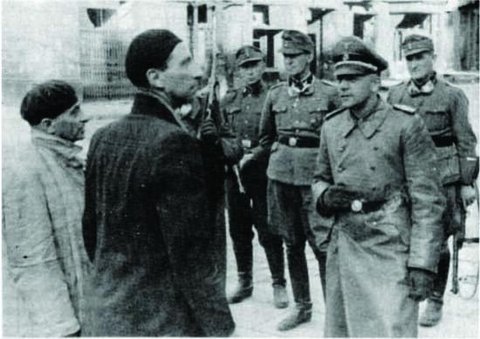
Erich Steidtmann (November 15, 1914 - July 25, 2010) was a Nazi SS officer believed to have been involved in the liquidation of the Warsaw Ghetto Uprising, the largest single revolt by the Jews during the Holocaust, the bulk of which occurred from April 19 until May 16, 1943, ending when the resistance was crushed by German troops under the direct command of Jürgen Stroop. Efforts were being undertaken by German prosecutors in the months before his death to prosecute Steidtmann for his involvement in war crimes.
Steidtmann was born on November 15, 1914, in Weißenfels and joined the SS on June 1, 1933. In 1942, as commander of a police unit, the Third Battalion of Police Regiment 22, Steidtmann guarded trains used for the deportation of Polish Jews from the Warsaw Ghetto to the Treblinka extermination camp. His unit remained in the ghetto through 1943, where it would have been involved in the liquidation of the Ghetto under Gen. Jürgen Stroop in which 55,000 people were killed or sent to the death camps. Though Steidtmann had denied that he was involved in the events in the Warsaw Ghetto, witnesses placed him there. He was later assigned to Police Battalion 101, which was involved in the November 1943 "Harvest Festival" in which Jews in camps near Lublin were systematically shot and killed. Steidtmann also claimed not to have been in the area during the killings in Lublin, saying he had been on leave, but letters he had written at the time provided evidence that he was present.
Steidtmann was captured by British forces after the conclusion of the war, but was not tried. He became a police officer in Essen and later became a driving instructor in Hanover. He had been questioned on a number of occasions during the 1960s, but had never been charged with any crimes.
In 2007, an autobiography written by a German woman stated that she had had an affair with Steidtmann during the war, and Steidtmann filed a libel suit against the author, Lisl Urban, arguing that his "honor had been besmirched". In mounting its defense, the book's publishers Joachim Jahns contacted the Simon Wiesenthal Center's staff in Germany, which found evidence that Steidtmann had earlier admitted to being involved in the suppression of the Warsaw Ghetto Uprising. In April 2007, the Süddeutsche Zeitung printed a letter that included a military code that showed he had been in Lublin during the massacres there. German prosecutors initiated efforts to confirm his presence in Lublin during the period in question.
While the investigation was in progress, Steidtmann died of a heart attack at age 95, on July 25, 2010. Dr. Efraim Zuroff of the Simon Wiesenthal Center expressed his frustration with Steidtmann's death and the general difficulties in bringing suspected Nazi war criminals to justice more than six decades after the end of World War II, saying "I sometimes say that I am the only Jew in the world who prays for the health of Nazi war criminals". Zuroff noted that the Center would never have become involved in the investigation if Steidtmann had not brought attention to his case by filing the libel suit and that "had the prosecutors done their job properly in the sixties, he would not have escaped justice".
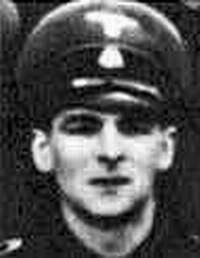
SS-Oberscharführer Franz Bürkl (August 16, 1911 - September 7, 1943) was a Gestapo officer in the Nazi - occupied Poland. He was assassinated in the Operation Bürkl on 7 September 1943.
Bürkl was responsible for numerous executions, summary executions and other killings of the Polish Jews and prisoners of the infamous Pawiak prison in Warsaw (including civilian hostages and Soviet prisoners of war), where he was both a Zugführer (guard shift leader) and a deputy commander. Between 1941 and 1943 he personally murdered several dozen people, both in and outside the prison, including during his trips into the Warsaw Ghetto where he shot people at random. During the Warsaw Ghetto Uprising a group of jailers from Pawiak, under the command of Bürkl, volunteered to help in the hunt for the Jews. He was said to be addicted to morphine and was never seen separated from his big German Shepherd Dog named Kastor which he used to terrorize the prisoners of Pawiak. Prominent among his victims was Dionizy Błeszyński, an Armia Krajowa (AK) district commander who was arrested and hanged in 1943.
In 1943 Bürkl, as "a sadist and a mass murderer", was convicted of crimes against the Polish nation by the Polish resistance's Special Courts, sentenced to death, and shot dead on the street of Warsaw in Operation Bürkl a part of Operation Heads. Franz Burkl was shot dead by the soldiers of the Polish Home Army AK Head Command. He was shot by the operation leader Jerzy Zoborowski "Jeremy" and Bronislaw Pietraszewicz "Lot".